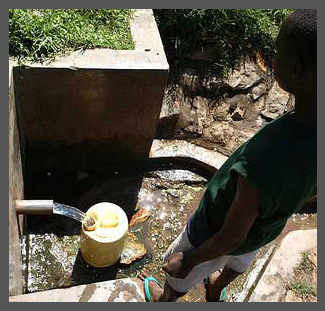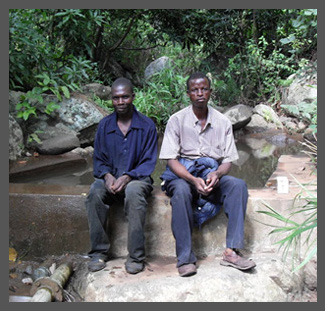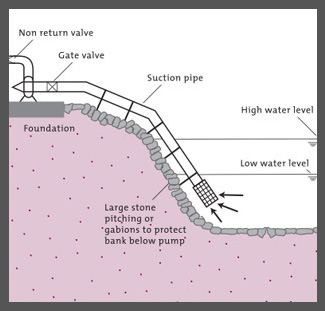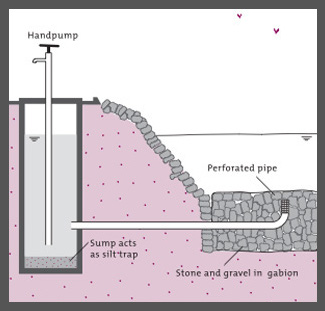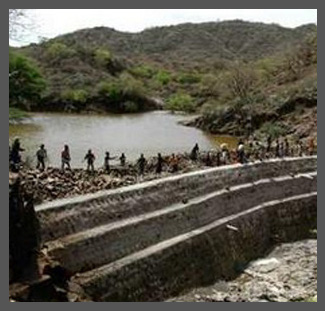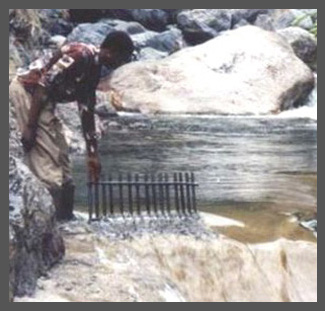Difference between revisions of "Aguas superficiales"
| (25 intermediate revisions by 2 users not shown) | |||
| Line 1: | Line 1: | ||
| + | {{Language-box|english_link=Water Portal / Rainwater Harvesting / Surface water| french_link=Eaux superficielles |spanish_link=Aguas superficiales | hindi_link=वाटर पोर्टल / वर्षाजल संचयन / सतही जल |malayalam_link=ഉപരിതല ജലം | swahili_link=coming soon | korean_link=coming soon | chinese_link=地表水(中文) | indonesian_link=Panen Air Hujan / Air Permukaan | japanese_link= 地表水}} | ||
| + | |||
El agua pluvial que no se capta directamente, que no se usa para fines agrícolas y que no se absorbe en la tierra se convierte en agua superficial. La captación de aguas superficiales incluye a todos los sistemas que recolectan y conservan la escorrentía superficial después de una tormenta o en corrientes de agua intermitentes, ríos o humedales para su almacenamiento en estanques y depósitos abiertos. Esto puede proporcionar agua para uso doméstico directo (generalmente necesita tratamiento), riego, ganadería y acuicultura. Otro objetivo de la captación de aguas superficiales es el almacenamiento, ya sea a través de depósitos abiertos o de la infiltración directa a los acuíferos bajo tierra. El agua se preserva mejor cuando se almacena en acuíferos, dado que se evita la evaporación que ocurre en los sistemas de depósito abiertos. | El agua pluvial que no se capta directamente, que no se usa para fines agrícolas y que no se absorbe en la tierra se convierte en agua superficial. La captación de aguas superficiales incluye a todos los sistemas que recolectan y conservan la escorrentía superficial después de una tormenta o en corrientes de agua intermitentes, ríos o humedales para su almacenamiento en estanques y depósitos abiertos. Esto puede proporcionar agua para uso doméstico directo (generalmente necesita tratamiento), riego, ganadería y acuicultura. Otro objetivo de la captación de aguas superficiales es el almacenamiento, ya sea a través de depósitos abiertos o de la infiltración directa a los acuíferos bajo tierra. El agua se preserva mejor cuando se almacena en acuíferos, dado que se evita la evaporación que ocurre en los sistemas de depósito abiertos. | ||
<small-title /> | <small-title /> | ||
| Line 9: | Line 11: | ||
|colspan="5" style="background-color:#efefef;"| | |colspan="5" style="background-color:#efefef;"| | ||
|- | |- | ||
| − | |style="background:#efefef;"|[[Image:springwater icon.png|center|80px|link=Springwater collection]] | + | |style="background:#efefef;"|[[Image:springwater icon.png|center|80px|link=Water Portal / Rainwater Harvesting / Surface water / Springwater collection]] |
| − | |style="background:#efefef;"|[[Image:intake icon.png|center|80px|link=Protected side intake]] | + | |style="background:#efefef;"|[[Image:intake icon.png|center|80px|link=Water Portal / Rainwater Harvesting / Surface water / Protected side intake]] |
| − | |style="background:#efefef;"|[[Image:intake icon.png|center|80px|link=River-bottom intake]] | + | |style="background:#efefef;"|[[Image:intake icon.png|center|80px|link=Water Portal / Rainwater Harvesting / Surface water / River-bottom intake]] |
| − | |style="background:#efefef;"|[[Image:intake icon.png|center|80px|link=Floating intake]] | + | |style="background:#efefef;"|[[Image:intake icon.png|center|80px|link=Water Portal / Rainwater Harvesting / Surface water / Floating intake]] |
| − | |style="background:#efefef;"|[[Image:intake icon.png|center|80px|link=Sump intake]] | + | |style="background:#efefef;"|[[Image:intake icon.png|center|80px|link=Water Portal / Rainwater Harvesting / Surface water / Sump intake]] |
|- | |- | ||
| − | |style="background:#efefef;"|[[Image:SpringwaterCollecting small.jpg|center|120px|link=Springwater collection]] | + | |style="background:#efefef;"|[[Image:SpringwaterCollecting small.jpg|center|120px|link=Water Portal / Rainwater Harvesting / Surface water / Springwater collection]] |
| − | |style="background:#efefef;"|[[Image:A river intake small.jpg|center|120px|link=Protected side intake]] | + | |style="background:#efefef;"|[[Image:A river intake small.jpg|center|120px|link=Water Portal / Rainwater Harvesting / Surface water / Protected side intake]] |
| − | |style="background:#efefef;"|[[Image:River-bottomIntake.JPG|center|120px|link=River-bottom intake]] | + | |style="background:#efefef;"|[[Image:River-bottomIntake.JPG|center|120px|link=Water Portal / Rainwater Harvesting / Surface water / River-bottom intake]] |
| − | |style="background:#efefef;"|[[Image:Floating Intake Diagram.jpg|center|120px|link=Floating intake]] | + | |style="background:#efefef;"|[[Image:Floating Intake Diagram.jpg|center|120px|link=Water Portal / Rainwater Harvesting / Surface water / Floating intake]] |
| − | |style="background:#efefef;"|[[Image:SumpIntakeDiagram.JPG|center|120px|link=Sump intake]] | + | |style="background:#efefef;"|[[Image:SumpIntakeDiagram.JPG|center|120px|link=Water Portal / Rainwater Harvesting / Surface water / Sump intake]] |
|- | |- | ||
| − | |style="background:#efefef;"|<div class="center" style="width:auto; margin-left:auto; margin-right:auto;">[[Springwater collection|Captación de aguas de manantial]]</div> | + | |style="background:#efefef;"|<div class="center" style="width:auto; margin-left:auto; margin-right:auto;">[[Water Portal / Rainwater Harvesting / Surface water / Springwater collection|Captación de aguas<br> de manantial]]</div> |
| − | |style="background:#efefef;"|<div class="center" style="width:auto; margin-left:auto; margin-right:auto;">[[ | + | |style="background:#efefef;"|<div class="center" style="width:auto; margin-left:auto; margin-right:auto;">[[Water Portal / Rainwater Harvesting / Surface water |Toma lateral <br>con protección]]</div> |
| − | |style="background:#efefef;"|<div class="center" style="width:auto; margin-left:auto; margin-right:auto;">[[ | + | |style="background:#efefef;"|<div class="center" style="width:auto; margin-left:auto; margin-right:auto;">[[Water Portal / Rainwater Harvesting / Surface water |Toma de fondo]]</div> |
| − | |style="background:#efefef;"|<div class="center" style="width:auto; margin-left:auto; margin-right:auto;">[[ | + | |style="background:#efefef;"|<div class="center" style="width:auto; margin-left:auto; margin-right:auto;">[[Water Portal / Rainwater Harvesting / Surface water |Toma flotante]]</div> |
| − | |style="background:#efefef;"|<div class="center" style="width:auto; margin-left:auto; margin-right:auto;">[[ | + | |style="background:#efefef;"|<div class="center" style="width:auto; margin-left:auto; margin-right:auto;">[[Water Portal / Rainwater Harvesting / Surface water |Toma de pozo]]</div> |
|- | |- | ||
|colspan="5" style="background-color:#efefef;"| | |colspan="5" style="background-color:#efefef;"| | ||
| Line 33: | Line 35: | ||
|colspan="5" style="background-color:#efefef;"| | |colspan="5" style="background-color:#efefef;"| | ||
|- | |- | ||
| − | |style="background:#efefef;"|[[Image:dam icon.png|center|80px|link=Catchment and storage dams]] | + | |style="background:#efefef;"|[[Image:dam icon.png|center|80px|link=Water Portal / Rainwater Harvesting / Surface water / Catchment and storage dams]] |
| − | |style="background:#efefef;"|[[Image:Tyrolean_weir_icon.png|center|80px|link=Tyrolean weir]] | + | |style="background:#efefef;"|[[Image:Tyrolean_weir_icon.png|center|80px|link=Water Portal / Rainwater Harvesting / Surface water / Tyrolean weir]] |
| − | |style="background:#efefef;"|[[Image:runoff icon.png|center|80px|link=Road runoff harvesting]] | + | |style="background:#efefef;"|[[Image:runoff icon.png|center|80px|link=Water Portal / Rainwater Harvesting / Surface water / Road runoff harvesting]] |
| − | |style="background:#efefef;"|[[Image:micro hydro icon.png|center|80px|link=Micro hydropower]] | + | |style="background:#efefef;"|[[Image:micro hydro icon.png|center|80px|link=Water Portal / Rainwater Harvesting / Surface water / Micro hydropower]] |
|- | |- | ||
| − | |style="background:#efefef;"|[[Image:Catchment dam small.jpg|center|120px|link=Catchment and storage dams]] | + | |style="background:#efefef;"|[[Image:Catchment dam small.jpg|center|120px|link=Water Portal / Rainwater Harvesting / Surface water / Catchment and storage dams | Catchment and <br>storage dams]] |
| − | |style="background:#efefef;"|[[Image:Tyrolean_weir_small.JPG|center|120px|link=Tyrolean weir]] | + | |style="background:#efefef;"|[[Image:Tyrolean_weir_small.JPG|center|120px|link=Water Portal / Rainwater Harvesting / Surface water / Tyrolean weir | Tyrolean weir weir]] |
| − | |style="background:#efefef;"|[[Image:road runoff small.jpg|center|120px|link=Road runoff harvesting]] | + | |style="background:#efefef;"|[[Image:road runoff small.jpg|center|120px|link=Water Portal / Rainwater Harvesting / Surface water / Road runoff harvesting | Road runoff harvesting]] |
| − | |style="background:#efefef;"|[[Image:woman micro hydro small.jpg|center|120px|link=Micro hydropower]] | + | |style="background:#efefef;"|[[Image:woman micro hydro small.jpg|center|120px|link=Water Portal / Rainwater Harvesting / Surface water / Micro hydropower | Micro hydropower]] |
|- | |- | ||
| − | |style="background:#efefef;"|<div class="center" style="width:auto; margin-left:auto; margin-right:auto;">[[Catchment and storage dams|Presas de captación <br>y almacenamiento]]</div> | + | |style="background:#efefef;"|<div class="center" style="width:auto; margin-left:auto; margin-right:auto;">[[Water Portal / Rainwater Harvesting / Surface water / Catchment and storage dams | Presas de captación <br>y almacenamiento]]</div> |
| − | |style="background:#efefef;"|<div class="center" style="width:auto; margin-left:auto; margin-right:auto;">[[Tyrolean weir|Toma tirolesa]]</div> | + | |style="background:#efefef;"|<div class="center" style="width:auto; margin-left:auto; margin-right:auto;">[[Water Portal / Rainwater Harvesting / Surface water / Tyrolean weir | Toma tirolesa]]</div> |
| − | |style="background:#efefef;"|<div class="center" style="width:auto; margin-left:auto; margin-right:auto;">[[Road runoff harvesting|Captación de escorrentía en sendas]]</div> | + | |style="background:#efefef;"|<div class="center" style="width:auto; margin-left:auto; margin-right:auto;">[[Water Portal / Rainwater Harvesting / Surface water / Road runoff harvesting | Captación de <br>escorrentía en sendas]]</div> |
| − | |style="background:#efefef;"|<div class="center" style="width:auto; margin-left:auto; margin-right:auto;">[[Micro hydropower|Energía microhidráulica]]</div> | + | |style="background:#efefef;"|<div class="center" style="width:auto; margin-left:auto; margin-right:auto;">[[Water Portal / Rainwater Harvesting / Surface water / Micro hydropower | Energía <br>microhidráulica]]</div> |
|- | |- | ||
|colspan="5" style="background-color:#efefef;"| | |colspan="5" style="background-color:#efefef;"| | ||
| Line 60: | Line 62: | ||
* CARE Nederland, ''Desk Study Resilient WASH systems in drought prone areas''. Octubre 2010. | * CARE Nederland, ''Desk Study Resilient WASH systems in drought prone areas''. Octubre 2010. | ||
* Wiki muy completo acerca del uso del agua para fines agrícolas.: [http://agropedia.iitk.ac.in/ Agropedia] | * Wiki muy completo acerca del uso del agua para fines agrícolas.: [http://agropedia.iitk.ac.in/ Agropedia] | ||
| − | |||
| − | |||
| − | |||
Latest revision as of 22:58, 25 February 2016
| |
|
|
|
|
|
|
|
|
El agua pluvial que no se capta directamente, que no se usa para fines agrícolas y que no se absorbe en la tierra se convierte en agua superficial. La captación de aguas superficiales incluye a todos los sistemas que recolectan y conservan la escorrentía superficial después de una tormenta o en corrientes de agua intermitentes, ríos o humedales para su almacenamiento en estanques y depósitos abiertos. Esto puede proporcionar agua para uso doméstico directo (generalmente necesita tratamiento), riego, ganadería y acuicultura. Otro objetivo de la captación de aguas superficiales es el almacenamiento, ya sea a través de depósitos abiertos o de la infiltración directa a los acuíferos bajo tierra. El agua se preserva mejor cuando se almacena en acuíferos, dado que se evita la evaporación que ocurre en los sistemas de depósito abiertos.
Consideraciones del cambio climático
En tiempo de sequía el cemento que se usa para construir las estructuras de captación de agua puede ser de mala calidad debido a la poca cantidad de agua (o uso de agua contaminada) utilizada en el proceso de fabricación del cemento. El incremento en la temperatura, consecuencia del cambio climático, puede aumentar la tasa de evaporación del agua en los depósitos abiertos o incrementar el volumen de escorrentía cuando las inundaciones dañan la infraestructura. Se enumeran estos y otros efectos junto con algunos consejos para poder adaptar el sistema de agua a las condiciones del cambio climático.
Experiencias de campo
Estos proyectos pueden estar utilizando técnicas de captación de de aguas superficiales y forman parte de los proyectos listados en el Reporte Simplificado (Really Simple Reporting, RSR por sus siglas en Inglés) en Akvo.org.
Enlaces de aguas superficiales
- Rainwater Harvesting and Utilisation. Blue Drop Series: Book 2: Beneficiaries & Capacity Builders. ONU-HABITAT.
- CARE Nederland, Desk Study Resilient WASH systems in drought prone areas. Octubre 2010.
- Wiki muy completo acerca del uso del agua para fines agrícolas.: Agropedia
